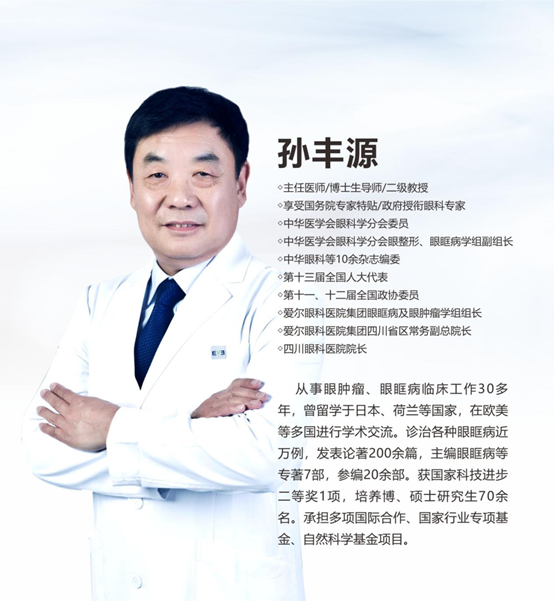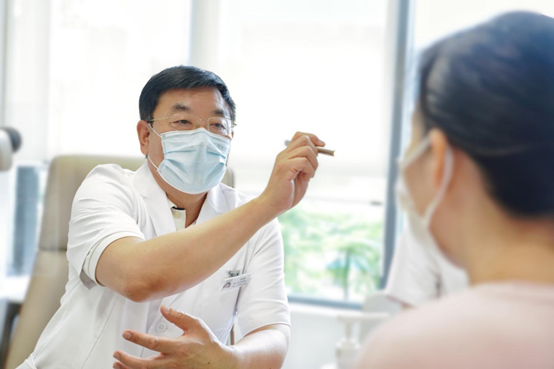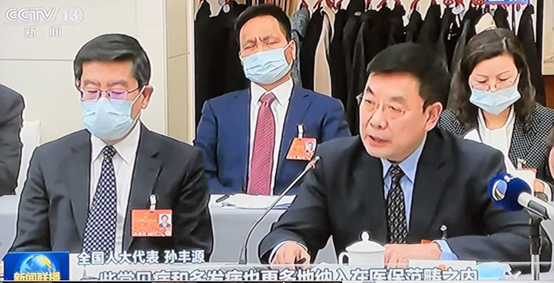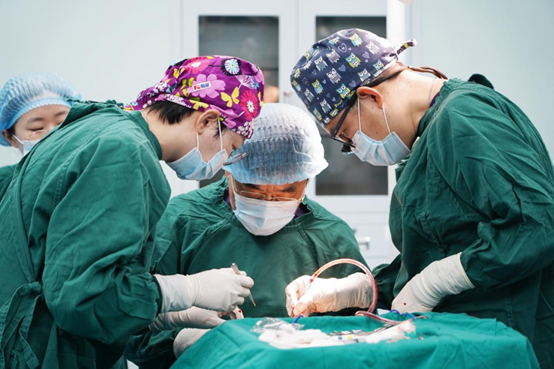As a saying in China goes, “If the flowers are blossoming, the butterfly will visit without being invited” In the middle of June, one big news from the ophthalmology community: On the 20th anniversary of AIER Eye Hospital Group (referred to as “AIER”), Professor Fengyuan Sun, an oculoplastic & orbit disease expert, the recipient of special subsidies from The State Council, ophthalmologist authorized by the Government, members of Chinese Ophthalmological Society, deputy team leader of Chinese Ophthalmological Society in oculoplastic & orbit disease group, the 11th and 12th member of the Chinese People's Political Consultative Conference (referred to as “CPPCC”) National Committee, the 13th Deputy to the National People's Congress (referred to as “NPC”), the doctoral supervisor, officially announced to join AIER as the head of the oculoplastic & orbit disease Group, he was also appointed Executive Vice Dean of AIER Eye Hospital in Sichuan Province and Dean of Sichuan Eye Hospital.
Previously, Dr. Tong Wu and Dr. Lina Wang from Prof. Fengyuan Sun's team have been appointed as Vice Dean and Head of the oculoplastic Department of Sichuan Eye Hospital respectively. With the collective joining of the top expert team of intractable orbital diseases, AIER will further enhance its ophthalmology diagnosis and treatment level and scientific research ability for sure. More than that, AIER is on the way accelerating to building the diagnosis and treatment centre of intractable diseases for the southwest and even the nation.

Prof. Fengyuan Sun
Well -known ophthalmologist: Paving the way for diagnosis and treatment of intractable orbital diseases
The size of the human eye, a hair's breadth, is just an ophthalmologist's battlefield. The tug of war between light and darkness is sometimes even in micron -- such as the diagnosis and treatment of intractable diseases
"Compared with common eye diseases such as cataract and glaucoma, the incidence of orbital diseases does not seem to be high, but there is a wide range of types. For example, there are about 100 kinds of orbital tumours, and orbital lesions caused by eye trauma, thyroid-related eye diseases and systemic diseases all belong to orbital diseases." Prof. Fengyuan Sun said, "It can be concluded that orbital diseases are characterized by various diseases, complex aetiology, difficult surgery and extensive systemic connections, which can endanger life in serious cases."
The development of orbital diseases in China can be traced back to around 1950. Prof. Guoxiang Song, a well-known expert of orbital diseases in China, his expertise in surgical operation earned him the title of progenitor. As a disciple of Prof. Guoxiang Song, Prof. Fengyuan Sun is developing by leaps and bounds in the late years.
Ophthalmic ultrasound products were introduced into clinics in the 1980s. At that time, China could not produce them independently and depended on imports, which greatly restricted the development of ophthalmic diagnosis and treatment in China. As an ophthalmologist who is determined to change China's excessive dependence on imported professional clinical medical equipment, Prof. Guoxiang Song's team resolutely participated in the research and development team. After repeated verification and continuous improvement, the team finally developed the Ultrasound Ophthalmology Diagnostic Instrument.
Now, as the Chairman of the Ophthalmology Committee of the Chinese Association of Ultrasound in Medicine and Engineering, Prof. Fengyuan Sun continues to do in-depth research to promote the development of eye disease diagnosis and treatment. The team led by Prof. Guoxiang Song and including Prof. Fengyuan Sun won the Second Prize of National Science and Technology Progress Award, which is also a national award in the field of ophthalmic oncology in China, for its contribution to the research of orbital tumours from foundation to start and to promote the comprehensive development of ophthalmic medicine.

Prof. Fengyuan Sun examines the patient's eyes
For many years, there are not many doctors engaged in the diagnosis and treatment of orbital diseases, one of the important reasons lies in the complexity of the diagnosis and treatment of orbital diseases, which requires general technical support and rich knowledge and experience reserved, internal medicine, surgery, neurology, ent, imaging, pathology, radiology... Not a single one can be omitted otherwise it can not meet the clinical needs, but also need a large number of cases to support.
To accelerate talent cultivation, Prof. Fengyuan Sun's team initiated the " National Training Center for Continuing Education " in China. Up to now, more than one thousand students have graduated, training and transporting a large number of leading figures in orbital diseases for hospitals across the country. We are saying that all the orbital doctors in well-known hospitals nationwide are related to Prof. Fengyuan Sun's team.
NPC deputy: With the original aspiration and stayed committed to the people-centred principle, the submission of "proposals and of deputies " become the " Chinese approach"
Prof. Fengyuan Sun as Visiting Professor, Orbital Center, University of Amsterdam, Netherlands, Member of the Asia Pacific Society of Oculoplastic & Orbit Disease, Assessment Experts of the National Natural Science Foundation of China, editorial board member of more than 10 journals such as the Chinese Academy of Ophthalmology, published more than 200 papers, edited 7 monographs such as orbital diseases, participated in the editing of more than 20 books, won the second prize of National Scientific and Technological Progress, and trained more than 70 doctoral and master students... With several national and international ophthalmology honours and heavyweight titles, Prof. Fengyuan Sun has made remarkable achievements in the development of Ophthalmology in China. In the community, Prof. Fengyuan Sun is well known as a professional ophthalmologist, countless patients who have no access to medical treatment have been cured with his help. In contrast, Fengyuan Sun's political identity as a member of the 11th and 12th members of the CPPCC National Committee, the 13th Deputy to the NPC is little known. But over the years, he has always taken this honour as a responsibility and mission, making serious proposals and fulfilling responsibilities, trying his best for the harmony and beauty of society,among the proposals and suggestions put forward by Prof. Fengyuan Sun, there are two suggestions which have received great attention from the state and society and have been comprehensively promoted throughout the country.
One is a proposal for the off-site settlement of medical insurance. As a member of the 12th member of the CPPCC National Committee and a nationally renowned ophthalmologist, a large number of patients from other places come to visit him every year, These patients have to pay the full cost themselves and then return to the local reimbursement. Patients generally report that advanced payment is high, with reimbursement procedures and a cumbersome process.
Based on extensive research, Prof. Fengyuan Sun submitted a proposal to the National Committee of the CPPCC on the implementation of long-distance medical insurance settlement. In the following years, they overcame numerous difficulties to continuously investigate, improve and refine the content of the proposal, and put forward the phased implementation steps of trial implementation in neighbouring provinces and promotion in the whole country, which played a driving role in the ultimate realization of the national network of the medical insurance settlement, so that the vast number of patients in different places for medical treatment will no longer suffer from "round-trip".
The other is a suggestion for the prevention and control of myopia in young people. This is an issue he has been paying constant attention to since he became a deputy to the 13th NPC. In recent years, he found in his work that myopia is characterized by a young age, high incidence and deep severity, which needs urgent attention. Whether in work or in the course of performing his duties, Prof. Fengyuan Sun has always been concerned about the eyesight problems of teenagers. With more and more children wearing "small glasses", Prof. Fengyuan Sun continued in-depth research to find the root of the problem, and bring the suggestion "On the comprehensive prevention and control of young myopia, improve the national eye health level" to the national "two sessions".
On August 30, 2018, 《Comprehensive Plan to Prevent Nearsightedness among Children and Teenagers》 issued by the Ministry of Education in collaboration with other competent authorities, which included the rate of myopia among children in the government's assessment indicators, it has become an important national strategic work.
Under the continuous attention of the state and society, all walks of life are making efforts to "protect the bright future of children". The implementation of a nationwide comprehensive program to protect children’s eye health has continuously been promoted.
As a well-known ophthalmologist and a deputy NPC, Prof. Fengyuan Sun always cares about patients and makes effort to do everything.

During the fifth session of the 13th NPC, Prof. Fengyuan Sun's suggestion was broadcast by the CCTV News
Join AIER: based in the southwest, cover nationwide will benefit the patients with eye diseases
To talk about why joined AIER, Prof. Fengyuan Sun revealed that the number of orbital doctors in China is small and the distribution is uneven, mainly concentrated in big cities. The patients in China are mostly in some places at the grassroots level. Sichuan is located in the hinterland of southwest China with a large population and a relatively high incidence of orbital diseases, but the medical resources are relatively insufficient.
AIER pays great attention to clinical, scientific research, talent training and the development concept of using ophthalmology, which makes him deeply inspired and shocked. In addition, AIER has been established for 20 years, with more than 700 medical institutions worldwide, 28 chain hospitals in Sichuan province, AIER hospitals are found in prefecture-level city, county-level city and remote areas, as well as in large cities. It can be said that in the past 20 years, AIER has made important contributions to the reform of the medical system and the solution of practical problems for patients. A large number of clinical case resources and data have also laid a solid foundation for scientific research.
"In the future, based on the platform of AIER, in the first stage, we will build an orbital disease diagnosis and treatment base in Sichuan Province and widely promoted. In the second stage, we plan to establish orbital disease centre incubation bases in provincial capital cities through online and offline teaching, gradually covering the whole country. In the third stage, we will extend the advanced diagnosis and treatment technology of orbital diseases to the whole country, so people can enjoy a high level of eye care services at their doorstep. “ Prof. Fengyuan Sun said, "Join AIER, do what I have learned all my life, and work side by side with like-minded ophthalmology colleagues to jointly defend patients' right to 'eye health'."

Prof. Fengyuan Sun, Dr. Tong Wu and Dr. Lina Wang jointly performed surgery for patients with intractable orbital diseases
The 20th anniversary of AIER: A galaxy of famous doctors, such a distinguished gathering to build a diagnosis and treatment centre for intractable orbital diseases
Mr.YingChuan Fan, Vice President of AIER in Sichuan Province said this year marks the 20th anniversary of AIER. Along the way, Sichuan Province has gathered and trained many ophthalmology elites, including a group of overseas returnees, Huaxi doctors, Zhongshan ophthalmic centre, Sun yat-sen Univerisity doctors, master and doctoral tutors, experts enjoying special subsidies from The State Council, as well as core experts with rich clinical experience. It covers dozens of ophthalmic specialities such as Optometry, Strabismus, Amblyopia & Pediatric Ophthalmology, Refractive Correction, Cataract, Glaucoma, Fundus, Ocular Trauma, Orbit disease, Lacrimal, Oculoplastics, Ophthalmology of traditional Chinese medicine, Ocular Surface and Corneal disease, etc. With the joining of Prof. Fengyuan Sun's team, AIER has formed the ability to build a diagnosis and treatment centre for intractable eye diseases in Sichuan Province, and the overall strength of AIER in Sichuan Province will be further enhanced.
Chengdu has become a "1+8+ N" strategic layout, one of the eight regional medical eye centres planned by AIER, through cooperation among powerful friends such as experts a round of visits and ophthalmology teaching services, resources sharing, complementary advantages and common development of ophthalmic medical services can be realized, so that eye disease patients in Southwest China can enjoy international and domestic high-quality diagnosis and treatment technology and services without leaving home.
